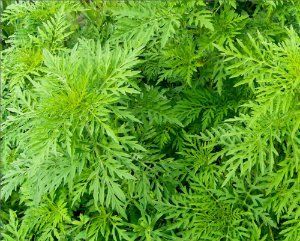Type: Ragweed is a flowering plant belonging to the Asteraceae family. It is an annual herb that can be highly invasive.
Height: This plant typically grows between 1 to 3 feet in height, with deeply lobed leaves and inconspicuous green flowers.
Where it grows: Ragweed is commonly found in disturbed areas, along roadsides, in fields, and vacant lots. It thrives in areas with full sunlight and well-drained soil.
Damage: Despite its unassuming appearance, ragweed is infamous for being a potent allergen producer. Its pollen, released into the air during late summer and fall, is a major trigger for hay fever and allergic rhinitis.
Ecological characteristics: Ragweed is a resilient plant that can adapt to various environmental conditions. It is highly prolific, producing a vast number of seeds, contributing to its spread and persistence.
Control Methods:
- Chemical Control: Utilizing herbicides can be an effective method for managing ragweed. Pre-emergent herbicides can prevent seed germination, while post-emergent ones can target established plants. However, care should be taken to choose herbicides that do not harm surrounding vegetation or wildlife.
- Mechanical Control: Physical removal of ragweed by hand pulling or cutting can be a labor-intensive but environmentally friendly method. It is crucial to remove the entire plant, including roots, to prevent regrowth. Regular mowing can also help control its spread.
- Biological Control: Introducing natural enemies, such as insects or fungi, that specifically target ragweed can be a sustainable approach. This method aims to reduce ragweed populations without resorting to chemical interventions.
- Growing Plants that Compete with Ragweed: Cultivating and strengthening plants that compete with ragweed, preferably non-weeds, can be an effective control strategy. These plants create a competitive environment, limiting the growth and spread of ragweed.
Examples of Competing Plants:
- Beautiful flowering plants like lilies (Lilium spp.), enhancing garden aesthetics while impeding weed infiltration.
- Broad-leaved plants, such as lupines (Lupinus spp.), creating shade and competing for sunlight.
- Perennial herbs like thyme (Thymus spp.), aiding in ragweed control and enriching the soil.
Preventing Spread:
To curb the spread of ragweed, it is essential to adopt preventive measures:
- Early Detection and Removal: Identifying and removing ragweed plants in their early stages can prevent the production and dispersal of pollen, reducing allergic reactions and stopping seed production.
- Maintaining Landscape Hygiene: Regularly clearing areas prone to ragweed growth, such as abandoned lots or unkempt fields, can hinder its establishment. Additionally, controlling soil erosion helps prevent the spread of ragweed seeds.
- Educating the Community: Raising awareness about ragweed's impact on health and the environment is crucial. Encouraging responsible land management practices among the community can aid in collective efforts to control and prevent its spread.
In conclusion, combating ragweed requires a multifaceted approach, combining chemical, mechanical, and biological control methods with strategic preventive measures. By understanding its ecological characteristics and employing a variety of control strategies, we can mitigate the impact of this invasive plant on both human health and the environment.



